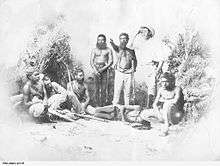William Willshire (policeman)
William Henry Willshire (10 March 1852 - 22 August 1925) was a controversial Australian police officer who worked in Alice Springs in the Northern Territory of Australia. He was the first police officer to be charged for murder in Australian history.
William Willshire | |
|---|---|
 Mounted Constable Willshire | |
| Personal details | |
| Born | William Henry Willshire 10 March 1852 Adelaide, South Australia |
| Died | 22 August 1925 (aged 73) Adelaide, South Australia |
| Nationality | Australian |
| Spouse(s) | Ellen Sarah Howell |
| Occupation | Police constable |

Early life and Alice Springs posting
Willshire was born on 10 March 1852 in Adelaide. He was the son of a schoolmaster James Doughty Willshire and his wife Emily Elizabeth (née Schlenkrich). In 1878, he joined the South Australian Police Force and was posted to Alice Springs four years later. By 1883, he was promoted to first-class mounted constable and then took charge of a 'native police force' consisting of six men, investigating incidents such as cattle spearing.
In 1886, he established the police station at Heavitree Gap. He also built a short-lived outpost at Boggy Hole near Hermannsburg. It was closed after three chained prisoners were shot in the back by police while allegedly escaping.
By 1890, he was responsible for more than 13 deaths of Aboriginal people, although that number may have been higher due to poor documentation of incidents.[1]
Murder trial
In 1891 Willshire's men attacked a group of sleeping Aboriginal people camped at Tempe Downs station, killing two. The incident was investigated by the then sub-protector of Aborigines, F. J. Gillen. Upon his recommendation, Willshire was the first policeman charged with murder and stood trial in Port Augusta.[2][3] The case was highly controversial. Public subscriptions raised £2000 for Willshire's bail and paid for his defence by Sir John Downer, the grandfather of Australian politician Alexander Downer. While Aboriginal witnesses gave evidence, Willshire was acquitted. While there was significant public support,[4][5] there was also outrage from those who opposed the finding, many of whom questioned the validity of the legal process.[6]
After the trial, Willshire was transferred to the Victoria River district in 1893 but was permanently removed from the position in 1895 for fear of further controversies and returned to Adelaide.[7][8]
Willshire wrote a semi-autobiographical book, A Thrilling Tale of Real Life in the Wilds of Australia, in 1895. He later applied for the position of state protector of Aborigines but was unsuccessful and resigned in 1908.[1]
Later life
Willshire married Ellen Sarah Howell on 13 September 1896 at Port Lincoln. They had a son and a daughter.[1]
He died on 22 August 1925 in Adelaide.
A street in The Gap, a suburb of Alice Springs, is named after him.[9]
References
- Mulvaney, D. J. Willshire, William Henry (1852–1925). Australian Dictionary of Biography. National Centre of Biography, Australian National University. Retrieved 28 April 2017.
- "ARREST OF MOUNTED-CONSTABLE WILLSHIRE". South Australian Register. LVI (13, 871). South Australia. 29 April 1891. p. 5. Retrieved 28 April 2017 – via National Library of Australia.
- "THE FINKE RIVER TROUBLE". South Australian Register. LVI (13, 872). South Australia. 30 April 1891. p. 6. Retrieved 28 April 2017 – via National Library of Australia.
- "M.C. Willshire". The Advertiser. XXXIV (10216). South Australia. 16 July 1891. p. 3. Retrieved 28 April 2017 – via National Library of Australia.
- "The Trial of M. C. Willshire". Evening Journal (Adelaide). XXIII (6501). South Australia. 24 July 1891. p. 3. Retrieved 28 April 2017 – via National Library of Australia.
- "THE WILLSHIRE TRIAL". Evening Journal (Adelaide). XXIII (6513). South Australia. 7 August 1891. p. 2. Retrieved 28 April 2017 – via National Library of Australia.
- "The Late Outrage by Victoria River Blacks". Northern Territory Times And Gazette. XX (1130). Northern Territory, Australia. 28 June 1895. p. 3. Retrieved 28 April 2017 – via National Library of Australia.
- "Outrage by Blacks". Northern Territory Times And Gazette. XX (1128). Northern Territory, Australia. 14 June 1895. p. 3. Retrieved 28 April 2017 – via National Library of Australia.
- "Willshire Street, The Gap, Northern Territory". Google Maps. Retrieved 28 April 2017.